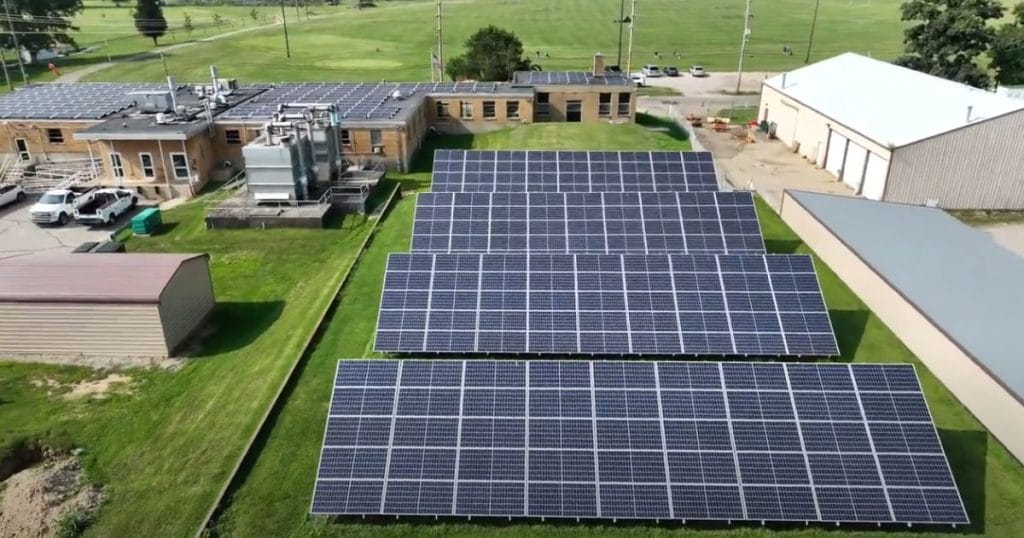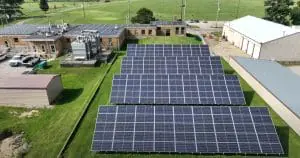Athens, Ohio (May 31, 2012)—In a time of speculation and worry over rising gas prices, utility rate hikes, and global climate change, many still consider renewable energy too costly.
Despite the continuing decline in the cost of solar power components, some policymakers and media voices (and some of the general public) continue to regard solar as “too expensive.” It comes up time and again on surveys. The fact is, the financial costs of solar are front-loaded—once the system is working, the fuel is forever free, and solar creates no emission or pollution. It’s a different cost equation than we see with fossil fuels, where unpredictable fuel costs go on forever, and the environmental costs are kicked down the road for future generations to bear.
A recent study* challenges the “solar is too expensive” slant by unraveling the actual costs and actual benefits that clean solar power generation provides to electric utilities, ratepayers, and taxpayers. After analyzing all the data, the study authors concluded that solar PV installations can deliver real value of $0.15/kWh to $0.40/kWh to ALL ratepayers and taxpayers, not just those installing solar systems.
Authored by Richard Perez at the University of Albany, Ken Zweibel at the GW Solar Institute, and Thomas E. Hoff of Clean Power Research, the study’s report declares, “It is clear that some possibly large value of solar energy is missed by traditional analysis.”
Although government- and utility-based incentives have proven to be a vital driver of solar power growth, the authors argue that the gulf between “inexpensive” conventional energy and “expensive” solar is far smaller than often portrayed, especially when larger public benefits are considered.
“This large apparent ‘grid-parity gap’ [between renewable energy costs and traditional grid-power costs] can hinder constructive dialogue and … weaken political support for solar incentives, especially during tight budgetary times,” the authors wrote.
According to the report, there is another way to look at incentives: as a logical means of transferring value from the public (ratepayers/taxpayers) to those who invested in the solar plants creating the $0.15/kWh to $0.40/kWh in direct solar benefits we all share.
How can this be? Where do these supposed public benefits come from, and what are they, exactly?
The Perez/Zweibel/Hoff report breaks down the shared-by-all public value of solar into nine specific accrued benefits. (The data used to derive the dollar values of these benefits was gathered and analyzed not in sunny Southern California or the Arizona desert, but in relatively non-sunny New York City.)
1. Savings on wholesale energy (comprise $0.06-$0.11/kWh of the total $0.15/kWh-$0.40/kWh). Locally generated clean electricity from residential and commercial solar installations reduces the amount of power that the public utilities must purchase at higher prices on the wholesale market.
2. Reducing demand-response expenses ($0.00-$0.05/kWh). “PV solar installations can deliver the equivalent of capacity, displacing the need to purchase this capacity elsewhere, e.g., via demand response,” the report explains.
3. Savings on energy losses within the distribution system ($0.00-$0.01/kWh). Distributing grid power is expensive and inefficient. When energy is moved from large power plants to local loads, electrical losses typically occur. These losses are much lower with distributed solar generation, where solar is built close to the load.
4. Reduced need for feeder equipment upgrades ($0.00-$0.03/kWh). Because distributed PV can deliver capacity at the feeder level, it can reduce the wear and tear on transformers and other feeder equipment.
5. Hedge against fuel-price spikes ($0.02-$0.03/kWh). “Solar energy is unaffected by fuel commodity price spikes—the fuel is free sunlight. traditional fuel commodity prices fluctuate on short-term scales and will likely escalate substantially over the long term,” the report says.
6. Grid stability ($0.03-$0.06/kWh). Solar power’s ability to closely mirror peak power demand can help reduce the chances of blackouts that can occur when the existing power system is overly stressed. [Peak grid demand normally occurs on hot summer afternoons, when solar is most productive and can add power to the grid when it needs it most.] Power outages currently cost the U.S. economy approximately $100 billion annually, according to the report.
7. Health-related and environmental gains ($0.03-$0.06/kWh). The deployment of solar power displaces the greenhouse gas emissions, mining-related consequences, water contamination, and other environmental- and health-related damages associated with fossil fuels. The $0.03-$0.06/kWh figure cited is “certainly a conservative range,” the report adds.
8. Long-term taxpayer benefits from reduced fuel-price volatility ($0.03-$0.04/kWh). Using an estimate of a 150% rise in fuel-based generation costs by 2036 (widely considered a conservative estimate), the report found that the “insurance hedge” of solar generation contributes a significant long-term value—less government spending on fuel reserves—in addition to the short-term fuel-price hedge value mentioned earlier.
9. Economic boost. The job-creation benefits of solar power have been demonstrated in numerous studies. Moreover, “Job creation implies value to society in many ways, including increased tax revenues, reduced unemployment, and an increase in general confidence conducive to business development,” the report explains.
*“Solar Power Generation in the U.S.: Too Expensive or a Bargain?” by Perez, Zweibel, Hoff.
Adapted from SOLAR INDUSTRY MAGAZINE, August 2011—Hidden Cost Savings: The Top 9 Public Benefits Of Installing Solar Power by Jessica Lillian
UPCOMING EVENT
Upcoming Saturday June 23, the annual SpiceBush Festival in Athens, Ohio—Third Sun Solar will deploy our solar trailer as a FREE CELLPHONE-RECHARGING STATION during the festival, which features live bands, craft brews, arts and crafts, food samples, and three types of brews made with Spicebush berries. There will be interactive children activities and educational talks about ways to use spicebush, as well as a spicebush cook-off at 4 p.m. Stop by our solar trailer and let us recharge your cell phone or camera.
ABOUT THIRD SUN SOLAR
Founded in 2000, Third Sun Solar is at the forefront of the emerging Ohio clean energy industry—a growing resource for 21st-century jobs. For more than a decade, the company has custom designed and installed over 300 renewable energy systems for its commercial, institutional, government, and residential customers across the Midwest. Third Sun Solar employs a team of NABCEP-certified solar energy system installers along with system designers, financial analysts, grant specialists, and support staff, all focused on making it easy for customers to go solar. The company combines financial and management experience, highly trained installation crews, privileged supply agreements with leading equipment manufacturers, a network of professional services partners, and advanced internal systems to deliver a smooth transition to solar energy at any scale. An Inc. 5000 company in 2009, 2010, and 2011, Third Sun Solar is a great choice for making your move to clean solar energy.





















